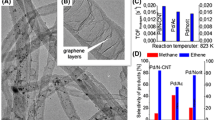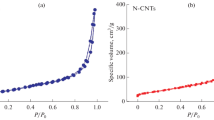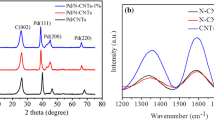Abstract
Nitrogen-doped carbon nanotubes (N-CNTs) containing different nitrogen species were synthesized via a chemical vapour deposition technique. This was archived by use of ferrocene and ferrocenyl-2-(4-cyanophenyl)acrylonitrile as catalysts. The N-CNTs were acid-treated and then used as Pd nanoparticle supports (Pd/N-CNTs). Both N-CNTs and Pd/N-CNTs were characterized by transmission electron microscopy, X-ray photoelectron spectroscopy and other spectroscopic techniques. The selective reduction of nitroarenes to anilines was used as a model reaction to test the effect of pyridinic- and pyrrolic-nitrogen species on the catalytic performance of Pd/N-CNTs. A larger number of pyridinic-nitrogens in the N-CNTs increased nitroarene conversion and enhanced the selectivity towards anilines as opposed to the pyrrolic-nitrogens. Also, pyridinic-nitrogens favoured the nucleation of Pd nanoparticles with higher surface areas than those nucleated in the presence of pyrrolic-nitrogens. Density functional theory calculations were employed to determine the band-gap energy and optimal geometry of Pd complexed to pyridine and pyrrole ligands. These results showed that the pyridine complex had a lower band-gap energy (5.804 eV) than the pyrrole complex (6.406 eV) implying that the former complex is more reactive than the later. Thus, the inclusion of pyridinic-nitrogens in the N-CNTs, used as support, favours Pd-catalyzed nitroarene reductions.












Similar content being viewed by others
References
Corma A, Garcia H (2008) Supported gold nanoparticles as catalysts for organic reactions. Chem Soc Rev 37:2096–2126
Blaser H-U, Steiner H, Studer M (2009) Selective catalytic hydrogenation of functionalized nitroarenes: an update. ChemCatChem 1:210–221
Tomkins P, Gebauer-Henke E, Leitner W, Mueller TE (2015) Concurrent hydrogenation of aromatic and nitro-groups over carbon-supported ruthenium catalysts. ACS Catal 5:203–205
Ombaka LM, Ndungu P, Nyamori VO (2013) Usage of carbon nanotubes as platinum and nickel catalyst support in dehydrogenation reactions. Catal Today 217:65–75
Figueras F, Coq B (2001) Hydrogenation and hydrogenolysis of nitro-, nitroso-, azo-, azoxy- and other nitrogen-containing compounds on palladium. J Mol Catal A Chem 173:223–230
Oosthuizen RS, Nyamori VO (2011) Carbon nanotubes as supports for palladium and bimetallic catalysts for use in hydrogenation reactions. Platin Met Rev 55:154–169
Xia W (2016) Interactions between metal species and nitrogen-functionalized carbon nanotubes. Catal Sci Technol 6:630–644
Chen P, Chew LM, Kostka A, Muhlera M, Xia W (2013) The structural and electronic promoting effect of nitrogen-doped carbon nanotubes on supported Pd nanoparticles for selective olefin hydrogenation. Catal Sci Technol 3:1964–1971
Ombaka LM, Ndungu PG, Nyamori VO (2015) Pyrrolic nitrogen-doped carbon nanotubes: physicochemical properties, interactions with Pd and their role in the selective hydrogenation of nitrobenzophenone. RSC Adv 5:09–122
Imrie C, Kleyi P, Nyamori VO, Gerber TIA, Levendis DC, Look J (2007) Further solvent-free reactions of ferrocenylaldehydes: synthesis of 1,10-ferrocenyldiimines and ferrocenylacrylonitriles. J Organomet Chem 692:3443–3453
Ombaka LM, Ndungu PG, Omondi B, McGettrick JD, Davies ML, Nyamori VO (2016) A facile approach towards increasing the nitrogen-content in nitrogen-doped carbon nanotubes via halogenated catalysts. JSSC 235:202–211
Ombaka LM, Ndungu PG, Omondi B, Nyamori VO (2014) Mechanochemical synthesis and spectroscopic properties of 1,1′-ferrocenyldiacrylonitriles: the effect of para-substituents. J Coord Chem 67:1905–1922
Suttisawat Y, Rangsunvigit P, Kitiyanan B, Williams M, Ndungu P, Lototskyy MV, Nechaev A, Linkov V, Kulprathipanja S (2009) Investigation of hydrogen storage capacity of multi-walled carbon nanotubes deposited with Pd or V. Int J Hydrog Energy 34:6669–6675
Frisch MJ, Trucks G, Schlegel H, Scuseria G, Robb M, Cheeseman J, Scalmani G, Barone V, Mennucci B, Petersson G (2009) Gaussian 09, revision A. 1. Gaussian Inc, Wallingford
Zhang Z, Lina L, Wang L (2010) Atmospheric oxidation mechanism of naphthalene initiated by OH radical. A theoretical study. Phys Chem Chem Phys 14:2645–2650
Boese AD (2015) Density functional theory and hydrogen bonds: are we there yet? ChemPhysChem 16:978–985
Saron C, Gérald M, Viktorya A, Manuel FR (2008) Deamidation of asparagine residues: direct hydrolysis versus succinimide-mediated deamidation mechanisms. J Phys Chem A 113:1111–1120
Leonid S (2012) Chemissian (Version 3.3): Chemissian. Retrieved from http://www.chemissian.com/
Kurgat C, Kibet K, Cheplogoi P (2016) Molecular modeling of major tobacco alkaloids in mainstream cigarette smoke. Chem Cent J 10:1–11
Chung HT, Zelenay P (2015) A simple synthesis of nitrogen-doped carbon micro- and nanotubes. Chem Commun 51:13546–13549
Sumpter BG, Meunier V, Romo-Herrera JM, Cruz-Silva E, Cullen DA, Terrones H, Smith DJ, Terrones M (2007) Nitrogen-mediated carbon nanotube growth: diameter reduction, metallicity, bundle dispersability, and bamboo-like structure formation. ACS Nano 1:369–375
Ombaka LM, Ndungu PG, Nyamori VO (2015) Tuning the nitrogen content and surface properties of nitrogen-doped carbon nanotubes synthesized using a nitrogen-containing ferrocenyl derivative and ethylbenzoate. J Mater Sci 50:1187–1200. doi:10.1007/s10853-014-8675-4
Cheng Y, Memar A, Saunders M, Pan J, Liu C, Gale JD, Demichelis R, Shen PK, Jiang SP (2016) Dye functionalized carbon nanotubes for photoelectrochemical water splitting—role of inner tubes. J Mater Chem A 4:2473–2483
Keru G, Ndungu PG, Nyamori VO (2013) Nitrogen-doped carbon nanotubes synthesised by pyrolysis of 4-{[(pyridin-4-yl)-methylidene]amino}phenyl)ferrocene. J Nanomater 2013:1–7
Bulusheva LG, Okotrub AV, Kinloch IA, Asanov IP, Kurenya AG, Kudashov AG, Chen X, Song H (2008) Effect of nitrogen doping on Raman spectra of multi-walled carbon nanotubes. Phys Status Solidi (b) 245:1971–1974
Chizari K, Vena A, Laurentius L, Sundararaj U (2014) The effect of temperature on the morphology and chemical surface properties of nitrogen-doped carbon nanotubes. Carbon 68:369–379
Sharifi T, Nitze F, Barzegar HR, Tai C-W, Mazurkiewicz M, Malolepszy A, Stobinski L, Wågberg T (2012) Nitrogen doped multi walled carbon nanotubes produced by CVD-correlating XPS and Raman spectroscopy for the study of nitrogen inclusion. Carbon 50:3535–3541
Wepasnick KA, Smith BA, Bitter JL, Fairbrother DH (2010) Chemical and structural characterization of carbon nanotube surfaces. Anal Bioanal Chem 396:1003–1014
Colomer J-F, Benoit J-M, Stephan C, Lefrant S, Van Tendeloo G, Nagy JB (2001) Characterization of single-wall carbon nanotubes produced by CCVD method. Chem Phys Lett 345:11–17
Chen P, Yang F, Kostka A, Xia W (2014) Interaction of cobalt nanoparticles with oxygen- and nitrogen-functionalized carbon nanotubes and impact on nitrobenzene hydrogenation catalysis. ACS Catal 4:1478–1486
Lei Z, Bai D, Zhao XS (2012) Improving the electrocapacitive properties of mesoporous CMK-5 carbon with carbon nanotubes and nitrogen doping. Microporous Mesoporous Mater 147:86–93
Luo Z, Lim S, Tian Z, Shang J, Lai L, MacDonald B, Fu C, Shen Z, Yu T, Lin J (2011) Pyridinic N doped graphene: synthesis, electronic structure, and electrocatalytic property. J Mater Chem 21:8038–8044
Yao Y, Zhang B, Shi J, Yang Q (2015) Preparation of nitrogen-doped carbon nanotubes with different morphologies from melamine-formaldehyde resin. ACS Appl Mater Interfaces 7:7413–7420
Kang ET, Neoh KG, Khor SH, Tan KL, Tan BTG (1990) X.p.s. studies of charge transfer interactions in some polyaniline complexes. Polymer 31:202–207
Kundu S, Xia W, Busser W, Becker M, Schmidt DA, Havenith M, Muhler M (2010) The formation of nitrogen-containing functional groups on carbon nanotube surfaces: a quantitative XPS and TPD study. Phys Chem Chem Phys 12:4351–4359
Lin Z, Waller GH, Liu Y, Liu M, Wong C-P (2013) Simple preparation of nanoporous few-layer nitrogen-doped graphene for use as an efficient electrocatalyst for oxygen reduction and oxygen evolution reactions. Carbon 53:130–136
Cao Y, Yu H, Tan J, Peng F, Wang H, Li J, Zheng W, Wong N-B (2013) Nitrogen-, phosphorous- and boron-doped carbon nanotubes as catalysts for the aerobic oxidation of cyclohexane. Carbon 57:433–442
An W, Turner CH (2009) Chemisorption of transition-metal atoms on boron- and nitrogen-doped carbon nanotubes: energetics and geometric and electronic structures. J Phys Chem C 113:7069–7078
Patil NM, Bhosale MA, Bhanage BM (2015) Transfer hydrogenation of nitroarenes into anilines by palladium nanoparticles via dehydrogenation of dimethylamine borane complex. RSC Adv 5:86529–86535
Gu X, Qi W, Xu X, Sun Z, Zhang L, Liu W, Pan X, Su D (2014) Covalently functionalized carbon nanotube supported Pd nanoparticles for catalytic reduction of 4-nitrophenol. Nanoscale 6:6609–6616
Melchionna M, Marchesan S, Prato M, Fornasiero P (2015) Carbon nanotubes and catalysis: the many facets of a successful marriage. Catal Sci Technol 5:3859–3875
Staykov A, Ooishi Y, Ishihara T (2014) Immobilizing metal nanoparticles on single wall nanotubes. Effect of surface curvature. J Phys Chem C 118:8907–8916
Pavia C, Giacalone F, Bivona LA, Salvo AMP, Petrucci C, Strappaveccia G, Vaccaro L, Aprile C, Gruttadauria M (2014) Evidences of release and catch mechanism in the Heck reaction catalyzed by palladium immobilized on highly cross-linked-supported imidazolium salts. J Mol Catal A Chem 387:57–62
Varadwaj GBB, Rana S, Parida K (2014) Pd(0) nanoparticles supported organofunctionalized clay driving C–C coupling reactions under benign conditions through a Pd(0)/Pd(II) redox interplay. J Phys Chem C 118:1640–1651
Osorio E, Vasquez A, Florez E, Mondragon F, Donald KJ, Tiznado W (2013) Theoretical design of stable small aluminium-magnesium binary clusters. Phys Chem Chem Phys 15:2222–2229
Rasheed L, Yousuf M, Youn I, Shi G, Kim KS (2016) An efficient non-reaction based colorimetric and fluorescent probe for highly selective discrimination of Pd0 and Pd2+ in aqueous media. RSC Adv 6:60546–60549
Hanulikova B, Kuritka I, Urbanek P (2016) Effect of backbone conformation and its defects on electronic properties and assessment of the stabilizing role of π–π interactions in aryl substituted polysilylenes studied by DFT on deca[methyl(phenyl)silylene]s. Chem Cent J 10:1–14
Dar T, Altarawneh M, Dlugogorski BZ (2012) Theoretical study in the dimerisation of 2-chlorothiophenol-2-chlorothiopheoxy: precursors to PCDT/TA. Organohalogen Compd 74:657–660
Acknowledgements
The authors wish to thank the University of KwaZulu-Natal and the National Research Foundation (NRF) for financial support. Dr. L.M. Ombaka is grateful for the award of doctoral bursary from the University of KwaZulu-Natal, College of Agriculture, Engineering and Science. We are grateful to Professor Bice Martincigh and Dr. R.S. Mwakubambanya for their insightful suggestions during the development of this manuscript and their assistance with proofreading.
Author information
Authors and Affiliations
Corresponding author
Rights and permissions
About this article
Cite this article
Ombaka, L.M., Ndungu, P.G., Kibet, J. et al. The effect of pyridinic- and pyrrolic-nitrogen in nitrogen-doped carbon nanotubes used as support for Pd-catalyzed nitroarene reduction: an experimental and theoretical study. J Mater Sci 52, 10751–10765 (2017). https://doi.org/10.1007/s10853-017-1241-0
Received:
Accepted:
Published:
Issue Date:
DOI: https://doi.org/10.1007/s10853-017-1241-0




